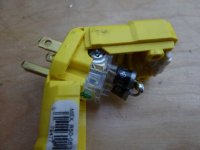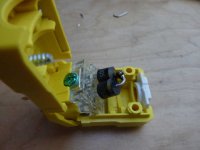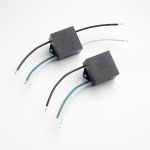Hi All,
I have bunch of Vishay TVS (Transient Voltage Suppressor) unidirectional diodes with Vb=170V. The exact part number is 5KP-170A-E3.
I am clumping hot and neutral of my $3-4 power strips with two of these diodes connected in series back to back.
Another variation on this theme is shown on the pictures. A diodes mounted in the power plug which in turn is plugged in one of the sockets of the power strip (cost around $4, 10 min to do it).
Is it worth doing or I am wasting my time? Your input is appreciated.
I have bunch of Vishay TVS (Transient Voltage Suppressor) unidirectional diodes with Vb=170V. The exact part number is 5KP-170A-E3.
I am clumping hot and neutral of my $3-4 power strips with two of these diodes connected in series back to back.
Another variation on this theme is shown on the pictures. A diodes mounted in the power plug which in turn is plugged in one of the sockets of the power strip (cost around $4, 10 min to do it).
Is it worth doing or I am wasting my time? Your input is appreciated.
Attachments
After a circuit breaker or fuse these are useful. Naked if they fail short they are a problem.
I've had a tube amp/preamp combo get struck by a lightning surge and carbon arc the power switch to "on" and blow the turn off pop capacitor to vapor: Without otherwise damaging the amp. So my solid state amps, I now use the 300 to 500 v MOS supressors out of VFD motor drives, between hot and neutral and also between neutral and safety ground. This is after the fuse. They will go short circuit during a big strike. Better replace a fuse & surpressor than 40-100 components.
The ones in motor drives are 22 mm and have a significant energy rating. The 7 mm ones in Radio Shack wall plug supressor accessories, those would go short in a couple of years in this lightning hot spot. You can actually buy the 15 mm ones as well as the 7 mm ones at distributors like Newark, but I haven't seen anybody stocking the 22 mm ones.
The physical size of the fuse is a consideration too. While one expects the main energy of a lightning surge to bleed off through an A/C or refrigerator motor somewhere, an "obsolete" old 1/4x1 1/4" fuse with a 5000 amp interrupt rating may be of more use stopping a strike than a 1000 amp interrupt rating 5mmx20 mm fuse. Breakers also have an interrupt current rating, the higher the better IMHO. If the breaker or fuse arcs across the after the MOS supressor goes short circuit, current could vaporize the supressor and still tear everything up <1500 v PIV rated .
I've had a tube amp/preamp combo get struck by a lightning surge and carbon arc the power switch to "on" and blow the turn off pop capacitor to vapor: Without otherwise damaging the amp. So my solid state amps, I now use the 300 to 500 v MOS supressors out of VFD motor drives, between hot and neutral and also between neutral and safety ground. This is after the fuse. They will go short circuit during a big strike. Better replace a fuse & surpressor than 40-100 components.
The ones in motor drives are 22 mm and have a significant energy rating. The 7 mm ones in Radio Shack wall plug supressor accessories, those would go short in a couple of years in this lightning hot spot. You can actually buy the 15 mm ones as well as the 7 mm ones at distributors like Newark, but I haven't seen anybody stocking the 22 mm ones.
The physical size of the fuse is a consideration too. While one expects the main energy of a lightning surge to bleed off through an A/C or refrigerator motor somewhere, an "obsolete" old 1/4x1 1/4" fuse with a 5000 amp interrupt rating may be of more use stopping a strike than a 1000 amp interrupt rating 5mmx20 mm fuse. Breakers also have an interrupt current rating, the higher the better IMHO. If the breaker or fuse arcs across the after the MOS supressor goes short circuit, current could vaporize the supressor and still tear everything up <1500 v PIV rated .
Last edited:
What is your mains supply maximum voltage?Hi All,
I have bunch of Vishay TVS (Transient Voltage Suppressor) unidirectional diodes with Vb=170V. The exact part number is 5KP-170A-E3.
I am clumping hot and neutral of my $3-4 power strips with two of these diodes connected in series back to back.
Another variation on this theme is shown on the pictures. A diodes mounted in the power plug which in turn is plugged in one of the sockets of the power strip (cost around $4, 10 min to do it).
Is it worth doing or I am wasting my time? Your input is appreciated.
That determines which TVS you need to select.
If your max is 127Vac then Vpk = 179.6Vpk
You need a TVS that at it's lowest tolerance does not pass when presented with 179.6Vpk.
That probably means you need to look very carefully at your TVS datasheet and find the tolerances and then select a TVS that is probably rated @ a nominal 190V or 200V for your 110/120vac supply.
170V seems far too low.
did you understand this?
Without upstream series resistance expect TVS diodes to fail
Last edited:
Re tubular fuses.
During high transient over current condition, the fuse wire filament in standard glass fuses can evaporate and coat the inside of the fuse with a conducting metallic film, rendering the fuse assy still conductive.
The solution is to specify ceramic tube/silica sand filled fuses which do reliably fail open circuit.
Dan.
During high transient over current condition, the fuse wire filament in standard glass fuses can evaporate and coat the inside of the fuse with a conducting metallic film, rendering the fuse assy still conductive.
The solution is to specify ceramic tube/silica sand filled fuses which do reliably fail open circuit.
Dan.
Last edited:
Without upstream series resistance expect TVS diodes to fail short circuit.
If you do get a spike expect to have to replace the house circuit fuse and the TVS diodes.
OTOH your gear will be well protected.
Dan.
Thanks, Guys
The whole idea is that diodes fail short and fuse will be blown if spike is strong and long enough. I do not mind that. what I do mind is the equipment protection.
Also, I am operating these devices for a year now and so far I had no blown fuses. For this device datasheet gives Vbr=189V and Vvm=170V (stand-off voltage)
Last edited:
What you are doing is very dangerous, guy! MOV's and Transorb/transils must be in series with a current limiting device, as a fuse, for example.
Hi Again,
I understand that it is dangerous, but the scenario is no different from that of equipment failure: short in any equipment and house circuit fuse goes off. Actually that fuse is in series with TVS, isn't it?
Last edited:
It takes 11 x the breaker rating, usually 20 amps, for several seconds, for a house breaker to go off. That is 220 amps for 3 or 4 seconds. That much energy.can start a major fire. All the failed microwaves and coffee pots on the curb after a big storm, those breakers mostly didn't trip. I imagine your little TVS would be long vaporized seconds before a house breaker would trip. Put a low energy fuse or breaker ahead of it, or don't use it at all. Breakers in "protected" outlet strips mostly are not refrigerator/AC duty types and will trip in tenths of a second at rated current. Protection outlet strips are the standard way to use these things, unless you're going to put in the actual appliance with its own fuse or breaker. My MOS supressors are inside a 3 amp fuse on the 120 watt amp or behind an 11 amp breaker in the 1300 kw amp. I learned this stuff by studying the home store outlet strips, then looking at blown up VFD drives to see how pros like Siemens AllenBradley or TB Woods condition their power in.
Don't believe me, look at a modern television. I salvaged some of a Sanyo LED 50" TV last summer, it had a proper breaker, toroid hash filter, then some suppressors on a little subassembly near the AC in. Or disassemble a PCAT power supply, they are super cheap and blow up after a year, but they've got the RF supression & the surge protection right.
Don't believe me, look at a modern television. I salvaged some of a Sanyo LED 50" TV last summer, it had a proper breaker, toroid hash filter, then some suppressors on a little subassembly near the AC in. Or disassemble a PCAT power supply, they are super cheap and blow up after a year, but they've got the RF supression & the surge protection right.
Without a fuse the TVS will pass transients that exceed it's striking voltage.
Your TVS probably blew up within a few minutes of being exposed to the mains interference that every mains supply has.
I suspect your TVS are now scrap. That's because they were rated too low for the level of peak transients you have.
Your TVS probably blew up within a few minutes of being exposed to the mains interference that every mains supply has.
I suspect your TVS are now scrap. That's because they were rated too low for the level of peak transients you have.
Without a fuse the TVS will pass transients that exceed it's striking voltage.
Your TVS probably blew up within a few minutes of being exposed to the mains interference that every mains supply has.
I suspect your TVS are now scrap. That's because they were rated too low for the level of peak transients you have.
Hi Andrew,
As I mentioned, they are operating without a problem more than a year. That does not mean of course that the setup is safe.
Hi All,
I have bunch of Vishay TVS (Transient Voltage Suppressor) unidirectional diodes with Vb=170V. The exact part number is 5KP-170A-E3...I am clumping hot and neutral of my $3-4 power strips with two of these diodes connected in series back to back...Is it worth doing or I am wasting my time? Your input is appreciated.
Instead of shunt TVS diodes, consider a series-mode surge protection module. For example, Littlefuse makes the LSP10 range of small modules, available from digikey for around $20, as I recall. I believe that the five-wire module in the photo is a series-mode version. The other module pictured is a three-wire version for shunt connection.
Attachments
Last edited:
Perhaps if you use two in series, plus another two in reverse series - that will provide local clamping for transients (the functional application for this device).
The device is not intended for voltage swell protection, where as Andrew has indicated, that part may be very close, if not starting to draw some current at waveform peaks for voltage levels at the high tolerance end of your mains voltage range.
Use a power strip that has at least some form of over-current protection designed in - most power strips where I am come with a cheap thermal circuit breaker switch.
You could also deploy the same series-reverse series circuit across the power transformer primary in any beloved audio gear, as a MOV would normally be placed to assist transient suppression when the amp's mains switch is turned off and transformer primary leakage inductance spikes.
Those parts have very high junction capacitance, so may not be a good idea for valve output transformer protection.
The device is not intended for voltage swell protection, where as Andrew has indicated, that part may be very close, if not starting to draw some current at waveform peaks for voltage levels at the high tolerance end of your mains voltage range.
Use a power strip that has at least some form of over-current protection designed in - most power strips where I am come with a cheap thermal circuit breaker switch.
You could also deploy the same series-reverse series circuit across the power transformer primary in any beloved audio gear, as a MOV would normally be placed to assist transient suppression when the amp's mains switch is turned off and transformer primary leakage inductance spikes.
Those parts have very high junction capacitance, so may not be a good idea for valve output transformer protection.
- Status
- This old topic is closed. If you want to reopen this topic, contact a moderator using the "Report Post" button.
- Home
- Amplifiers
- Power Supplies
- Clamping Hot and Neutral with TVS: worth doing?


